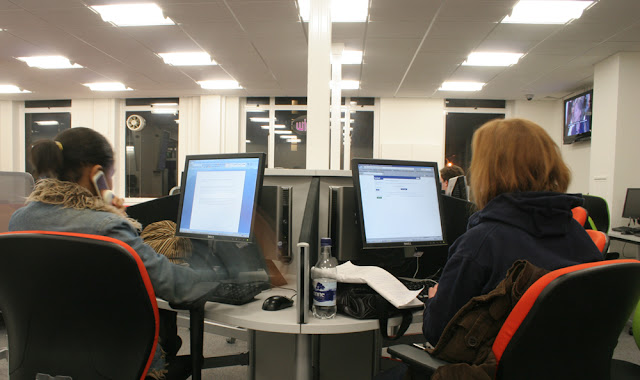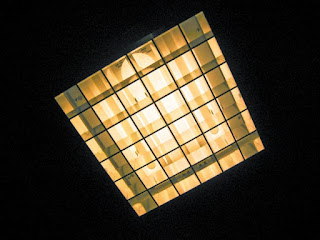TAG | commercial lighting
A THIRD of Britain’s office workers hate their lighting, a study by the respected pollsters Ipsos has discovered.
Some 32 per cent of white-collar employees told the researchers that they were unhappy with the light intensity, with only a fifth were able to alter the light level.
The results are sure to bolster critics of the lit environment in the nation’s commercial workplaces, who have slammed the sector for a lack of creativity. Top lighting designer Paul Nulty, founder of Nulty+, tweeted: ‘Bad lighting effects workplace productivity. Who’d have thought!?’
UK offices still have a preponderance of so-called Category 2 lights – recessed, deeply-louvred fittings designed to minimise reflections on computer screens – which deliver a gloomy environment.
The study of over 12,000 workers across 17 countries showed that the UK workers are the least satisfied with their office ambience. The study appeared to add weight to the argument that local lighting control boosts employee engagement and satisfaction, as the biggest issue was a lack of control. Only 39 per cent of respondents say they can adjust the temperature, while a mere 21 per cent can alter the lighting.
The so-called Category 2 light fixture has long dominated the UK’s offices, but its deep louvres are no longer necessary to prevent reflections on computer screens. Picture: Andrew Malone
‘This could be seriously affecting the concentration, productivity and engagement levels of workers, with the study showing that a lack of flexibility and control over the physical work environment correlates with a lack of engagement’, the study said. In contrast, highly engaged employees are those that have the most flexibility over how and where they work.
The situation in the UK is likely to be influenced by the country’s dominance of open-plan design, with 49 per cent of workers based in this kind of space due to its cost-saving benefits. However, this can limit employees’ individual control over their environment.
Christine Congdon, director of Global Research Communication told Lux: ‘Our research has consistently shown that the most engaged workers are those who have autonomy over how and where they work, whether adjusting the temperature, lighting, or workspace to suit their needs. ‘When people feel like they have choice and control over various aspects of their physical work environment, it leads to greater satisfaction overall.
‘Everybody is different and personal preference will depend on an individual’s natural physiology, their mood on a particular day and the task they are working on. To cater to these constantly changing needs, employers should pay more attention to providing a range of working environments, including the ability to adjust workspace basics as required.’
The study was commissioned by office furniture manufacturer Steelcase.
Visit us at www.novelenergylighting.com to explore our range of office lighting products, including LED panels and LED tubes. Call us to discuss your needs: 0208-540-8287, or drop us an email: sales@novelenergylighting.com
Main picture copyright Ripton Scott 2016
commercial lighting · led panels · led tubes · Novel Energy Lighting · office compliant lighting · office led · office lighting · productivity lighting
5
Why it pays to swap T5 lamps for LEDs
Comments off · Posted by admin in LED, LED downlights, LED Floodlights, LED GU10, LED Tubes, Philips LED
Coming to a Woolworths car park near you: the retailer is planning to roll out its LED lighting scheme to other stores following the massive energy savings it achieved in Coorparoo.

 Most of the new LED fittings will only be on when needed, thanks to an in-built motion sensor which instantly switches the light from the standby 8W light output to the full 35W output for a set period of time which can vary between 15 seconds and five minutes. When the set time ends, the light output returns to standby mode.
Most of the new LED fittings will only be on when needed, thanks to an in-built motion sensor which instantly switches the light from the standby 8W light output to the full 35W output for a set period of time which can vary between 15 seconds and five minutes. When the set time ends, the light output returns to standby mode.commercial lighting · energy efficient financing · led batten · led ip65 · LED lamps · led lighting · LED retrofit · led tubes · Novel Energy Lighting
18
Facility managers: ‘LEDs top all energy efficiency measures’
Comments off · Posted by admin in LED, LED downlights, LED panels

Lux Magazine reports: Let’s say you’re in charge of energy use at the company and you want to take big steps to slash the bill. Who you gonna call? A building insulator? A smart meter salesman? The most common answer is….
‘An LED vendor.’
That’s according to a poll of over 100 UK energy professionals in the public and private sector by Energy Live News (ELN), which asked them to name which measures they took over the last year, and which ones they are planning.
‘LEDs were the most popular choice for energy professionals to save energy over the last year – and they look set to remain favourites for the next 12 months,’ the website reported.
83 percent of respondents said they tapped LED lighting over the last year, and 80 percent said they’ll bring in LEDs over the next 12 months.
The number-two measure both for last year and the upcoming one didn’t even involve outright product purchases, as managers reported that ‘changing culture and behaviour’ was also high on their list (in other words, remember to turn off the efficient new LEDs).
The poll did not specifically ask about new boilers, solar panel installations or building managemet systems, although those did receive write-in votes.
‘Insulation, variable speed drives, AMT or smart meters and energy management systems tied third, each being installed over the last year by around two fifths of energy professionals,’ ELN wrote.
As popular as LEDs were among respondents, they elicited some reality checks from ELN readers in the website’s comments section.
‘When it comes to lighting LED is not quite the panacea for all ills it’s set up to be,’ wrote one.
‘Manufacturers are making grandiose claims about the longevity of these fittings without the evidence to back them up – the technology is so new there just haven’t been the number of hours in a year to claim they’ll last 100,000 hours or whatever they claim.’
To that, another reader shot back, ‘Have you not heard of accelerated testing?’ One fan of LEDs commented that it might still be too early to splash out for them.
‘Buying LED today may not be the best option,’ he said. ‘It might be better to wait a few years when efficacies will be even higher, as in many applications they have the potential to last 20-30 years and in that situation you may be better off with an optimised package that will go the distance.
’
In a cautionary tale, he added, ‘A lot of LED packages are poorly selected/sold and they will be replaced a lot earlier than hoped for.
’
Poorly sold? Hmmmm. Sounds like the poll needs a subcateory: Changing the culture and behaviour of vendors.
—
Photo: To avoid this sort of utility bill shock, energy managers are turning to LEDs more than anything. Image is from Shutterstock
commercial lighting · energy efficient lighting · facility management · LED lamps · led lighting · led lighting controls · Novel Energy Lighting · office lighting · smart controls
17
Government Aims to Slash Energy Demand for Lighting
Comments off · Posted by admin in LED, LED downlights, LED GU10, LED panels, LED Spots, LED Tubes, Philips LED

Lux Magazine reports: The government is considering ways to slash demand for energy by encouraging homes and businesses to install low-energy lighting and controls.
A consultation on ways to reduce demand for electricity was launched yesterday together with the Energy Bill, and runs until the end of January.
The Department of Energy and Climate Change (DECC) believes that a quarter of the potential energy savings to be made in homes by 2030 could come from getting rid of incandescent lamps, while lighting and controls could account for more than a third of savings in commercial properties and nearly half in the public sector (including streetlighting).
In the residential sector, the major barrier to adopting these technologies is a lack of awareness, the government believes, while in commercial buildings the main problems are the payback period on lighting upgrades and the fact that the person using a building and paying the bills is not always the one with the power to make changes.
The government is considering various financial incentives for energy-efficiency measures as well as voluntary and information-based approaches.
Engineering body Cibse has welcomed the consultation, saying it comes “better late than never”. Cibse said that simple improvements to building performance could make a huge difference to the amount of energy needed in the future.
Any new measures to promote efficiency will come on top of the Green Deal, set to be launched fully in the new year, which will provide finance packages allowing households and businesses to pay for energy-efficiency upgrades from savings on their bills.
Energy minister Ed Davey said the Energy Bill and associated measures are designed to drive low-carbon economic growth and “keep the lights on”.
Last year 39TWh of energy (that’s 39 billion kWh) was used to light commercial and public sector buildings, while around 15TWh was used in homes.
View our range of office lighting here:
commercial lighting · DECC · energy effficient lighting · led GU10 · LED lamps · led lighting · led panels · led tubes · lighting controls · low energy lighting · Novel Energy Lighting · smart controls
17
Energy-efficient lighting is ‘top green investment’
Comments off · Posted by admin in LED, LED downlights, LED GU10, LED panels, LED Tubes, Philips LED

Lux Magainze report: Energy-efficient lighting has come out top in a survey of green technology investments for businesses.
Over three quarters of businesses (77 per cent) polled by the Carbon Trust said they had invested in energy-efficient lighting in the past year, while 59 per cent had invested in employee training and 57 per cent had invested in energy metering and monitoring.
Almost all businesses surveyed said energy efficiency was an important consideration when buying or upgrading equipment.
However, the survey also highlighted reservations about the transition to the new technology, with only half of respondents (51 per cent) saying they were confident about manufacturers’ energy-efficiency claims.
Hugh Jones, managing director of business advice at the Carbon Trust said: ‘Our survey showed that return on investment is the most important factor for organisations considering investing in energy efficiency and low carbon technologies.’
The survey comes as the Carbon Trust launches the Green Business Directory, which lists suppliers that have been vetted under the trust’s Accredited Supplier scheme.
View our LED ceiling panel range here, ideal for offices:
commercial lighting · energy efficient lighting · energy savings · led controls · led GU10 · led lighting · led panels · led tubes · Novel Energy Lighting · smart controls






